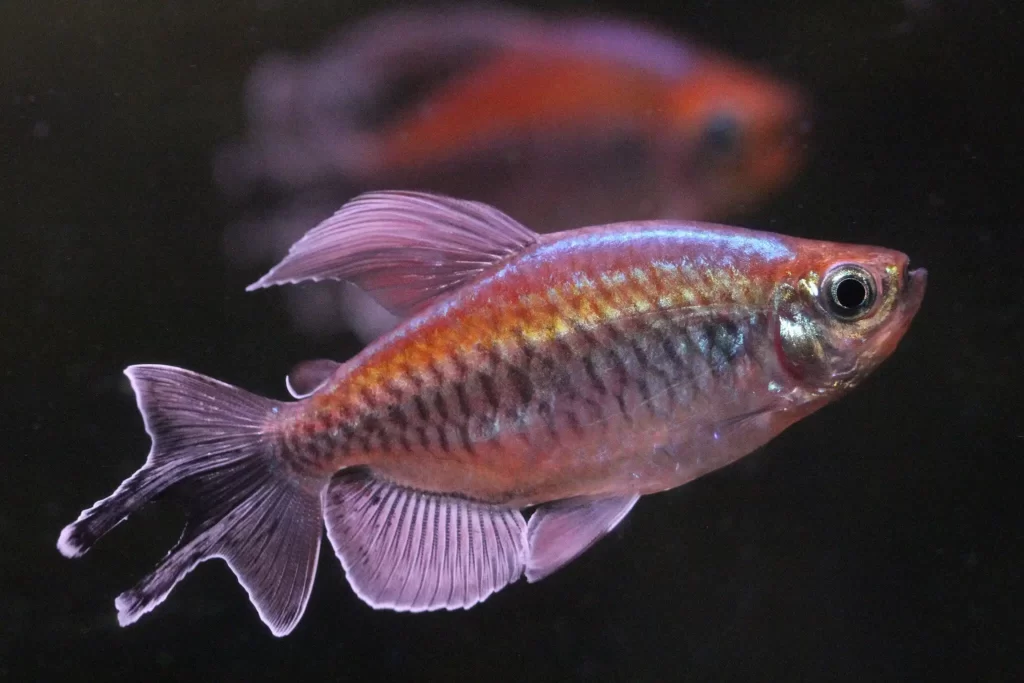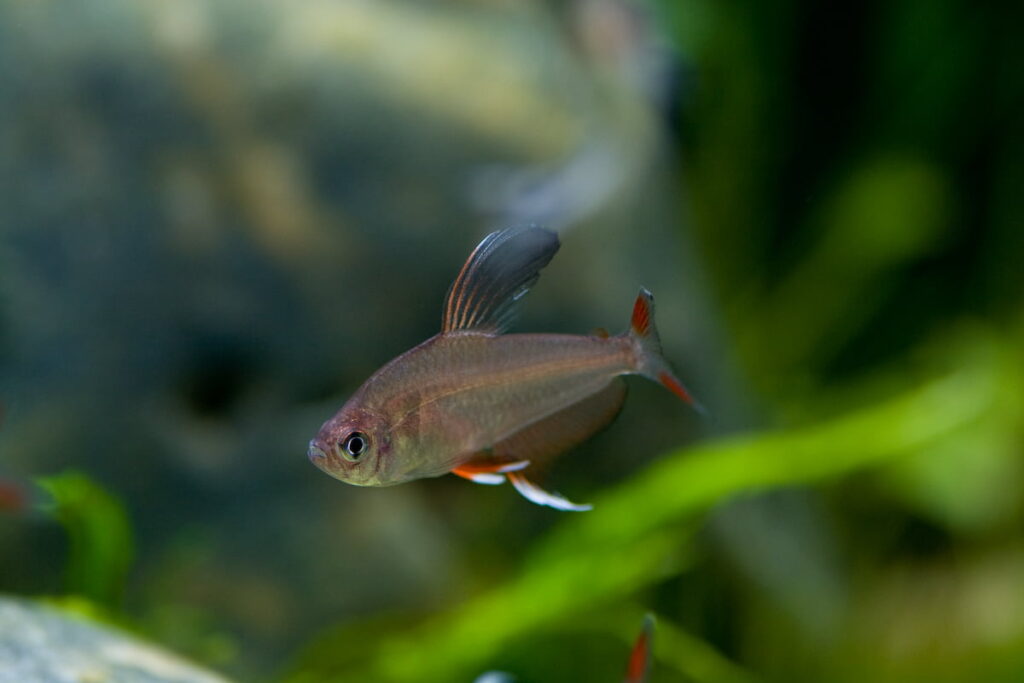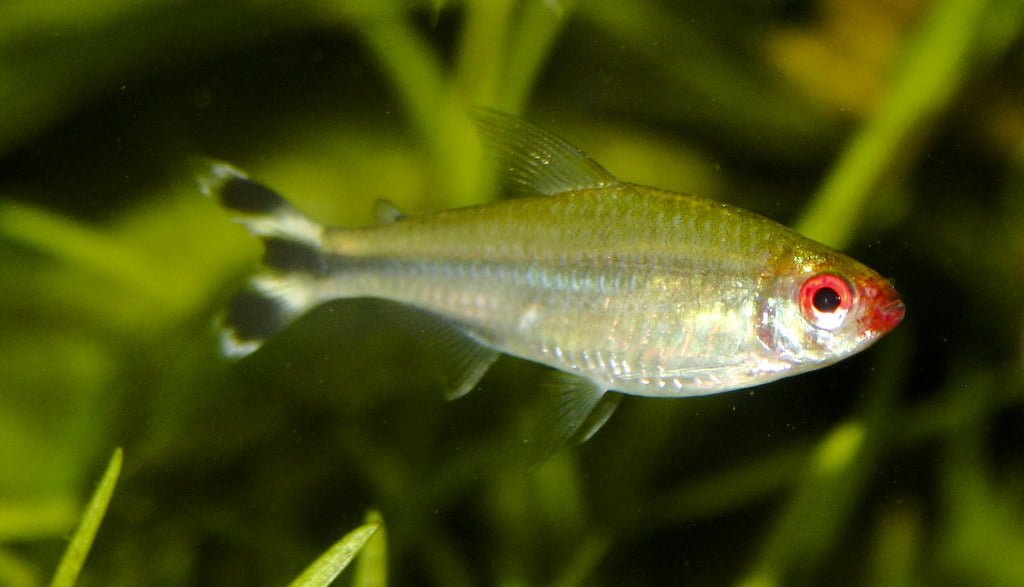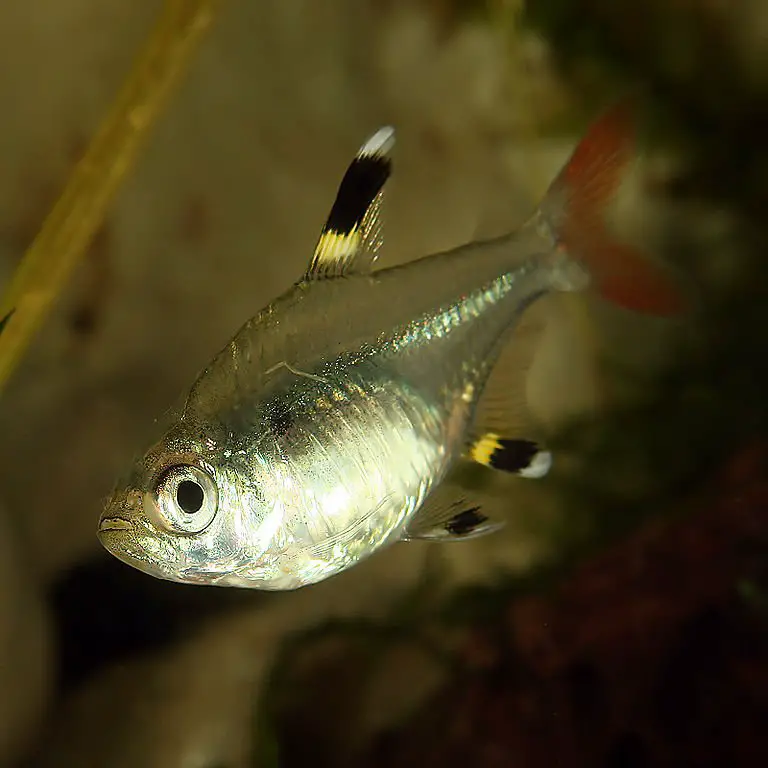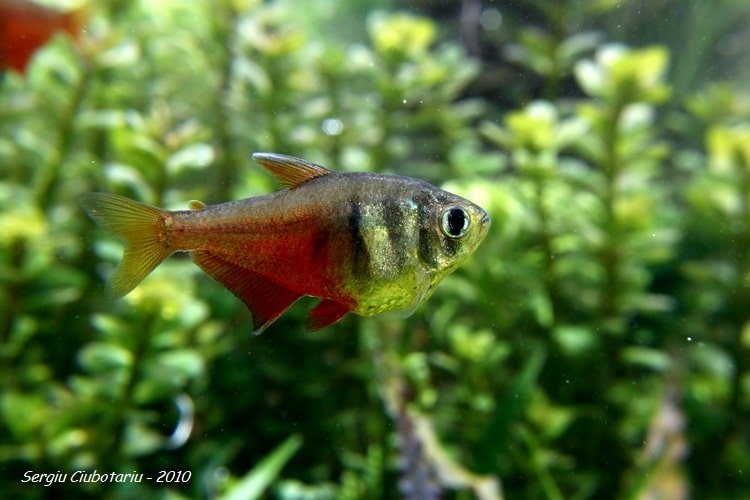Congo tetra (Scientific Name: “Phenacogrammus interruptus”) is one of the most attractive tetras you can keep in your community aquarium, probably the most gorgeous fish from the characin family. They are found in the regions of the Congo River in Africa. This is where these tetras got its name from “Congo Tetra.”
Congo tetras are overlooked in their adolescents because they don’t have the adult coloration yet. These tetras are extremely beautiful when they are fully grown with luminescent rainbow colors in their body and long, feathery like dorsal, anal, and tail fins.
One good news for aquarists is that this species is listed on the IUCN Red List as Least Concern (LC) because of its large population and no major widespread threats.
Among all the colorful tetra fish, Congo tetra is the most gorgeous and beautiful fish which shines all the colors of the rainbow, and rather than large scales, it has a typically full-bodied tetra shape.
Origin/Distribution and Habitat
You can guess the origin of this tetra by its name; Congo tetra is from the characin family originated from the regions of the Congo River Basin in Africa. The fish was not discovered until 1949 and was imported as an aquarium fish only after the 1960s.
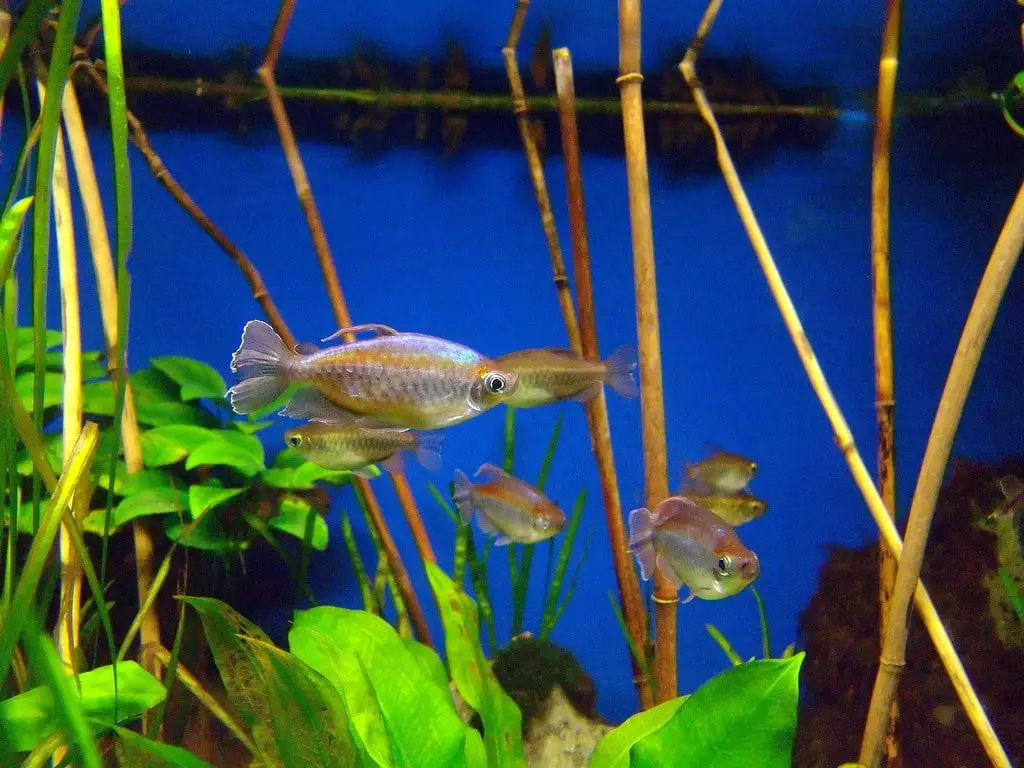
They are found in streams, slow-moving pools, marshes, and tributaries that have slightly acidic and mirky water. These habitats have plants, few rocks, a darker substrate, and no braches or woods.
Congo Tetras are schooling fish; they move in a group and feeds on worms, insects, plant matter, algae, crustaceans, and other zooplankton.
For years, captive breeders tried to breed congo tetra to reproduce its own kind but had mixed results. With each successful breeding, aquarists noticed the fish beauty diminished in successive generations. However, in the 1970s, a breeding facility in Florida perfected a breeding line. And now, the congo tetra you see in the pet store is from this very strain.
In captivity, Congo tetra needs to be kept in a group of its own kind.
To maintain the good health of Congo tetra, you should provide them plenty of space. A 40 gallons aquarium is ideal for a group of 20 congo tetras.
Although Congo tetra can adapt to a wide range of water parameters, maintaining aquarium water conditions is a must, or else they will lose their beautiful color.
Among Tetra, Congo tetra is more expensive and can be available with ease.
Description
Congo tetra has a typical shining tetra-shaped body with a larger scale. When Congo tetra gets mature, the iridescent color runs through the front to back, starting with blue on top, changing to red in the middle, yellow gold, and blue in the belly with a slight hint of green. Amazing rainbow luminescence makes this fish special among other strains of tetra fish.
Congo tetra is larger as compared to most of the types of tetra fish, the male being up to 3.0 inches (8.5 cm), whereas the female being up to 2.75 inches (6 cm). The male is larger and has extended tail fin and dorsal fin. The extended dorsal and tail fin develops into a most beautiful grayish-violet feathery appendage with white edges as the fish grows.
In the natural habitat, Congo tetra can live up to 7 years, but in captivity, their average life span is about 4.5 years.
Congo Tetra Characteristics
| Common Name | Congo Tetra |
| Scientific Name | Phenacogrammus interrupts |
| Origin | Congo River, Zaire in Africa |
| Family | Alestidae |
| Social Behavior | Schooling fish (peaceful and timid) |
| Adult size | 3 to 3 ½ inches |
| Lifespan | 3-5 Years |
| Diet | plant and meat products |
| Breeding | Egg Scatters |
| Care Level | Moderate |
| Temperature | 75-81degree F (24 -27degree C) |
| pH | 6.6 – 7.5 |
Congo Tetra Fish Care
The Congo Tetras are best kept by aquarists with some experience in fish keeping hobby. If you really want to keep Congo Tetra, you first need to know to care these fish require.
Congo Tetras are moderately hardy fish and are not so difficult to care for if you maintain the aquarium water parameter. These tetras are a bit sensitive to the quality of water. As the water quality degrades, their colors and marking slowly fades away.
20 dGh is the ideal water hardness to house your congo tetra with pH between 6-7.5.
The ideal water temperature for Congo tetra is 75-81degree F (24-27degree C).
As for the filtration system, congo tetras require good quality water. So you need to add a bigger aquarium filter that cleans your aquarium water effectively and has all the filtration media on it (biological, mechanical, and chemical filtration).
However, no matter what filtration system you choose, you to need to change 10% of the aquarium water every week, replacing it with fresh water. As the aquarium is a closed system, changing your aquarium water helps to maintain the water quality.
Congo tetras are schooling fish and should be kept in a group of at least 7-8 pairs. They also require a larger tank as compared to other tetras. You need at least 20 gallons capacity tank to house only congo tetra, but 40 gallons is ideal. The bigger, the better.
Almost all schooling fish loves to swim in the upper and middle layer of the river. You should have your tank hood on so that Congo tetra cannot jump out of the water tank.
Note: no matter what type of fish you house or what type of filtration system you use in your aquarium, water change of 10% every week is a must. The aquarium is a closed system for your fish; water doesn’t get to your tank unless you add it your self. Aquarium water gets contaminated with time, which needs to be removed, or else you will see dead fish on the surface of your tank.
How do you feel when you are locked in a washroom with nothing but human poop?
Congo tetra fish prefer soft, peat filtered water and dark substrate. You can ideally create a native biotope with lots of snags and plants and aquarium soil or darker substrate in it. The beautiful rainbow colors pop up real good with a darker substrate and lower light level.
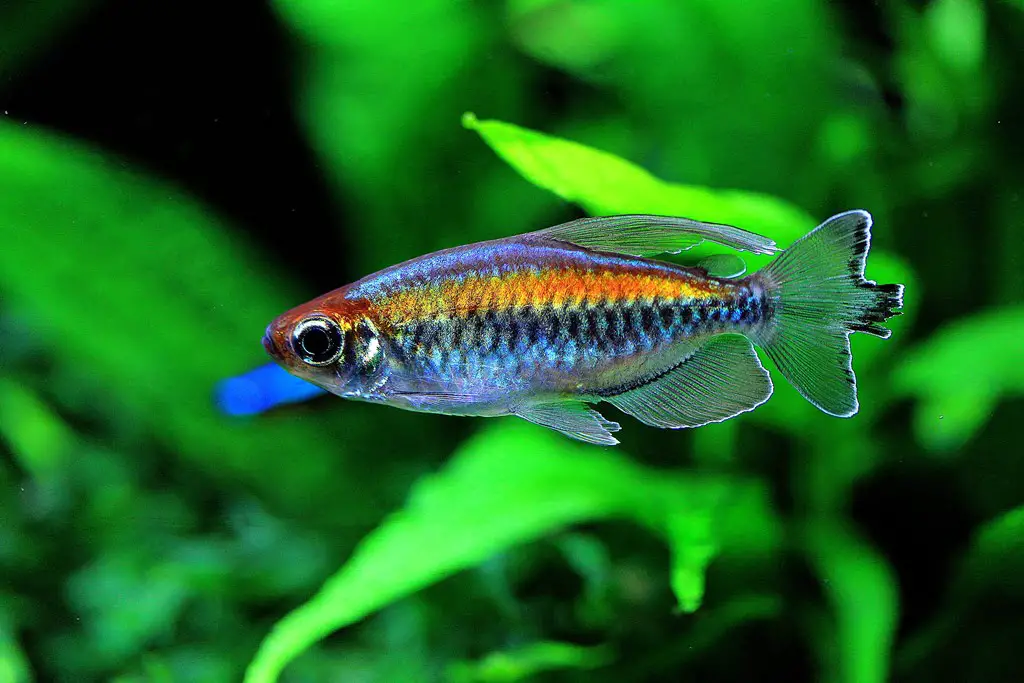
Congo Tetra Diet
In the wild, congo tetra mostly feeds on insects, small worms, crustaceans, plant matter, algae, and anything that fits in their mouth.
Congo tetras are easy to feed in captivity as well. As they are an omnivore, they accept any type of food you provide them with.
However, you need to maintain the ratio of 60% of insect foods and 40% of plant foods. Foods in the form of pellets, flakes, dried worms, blood worms, insects, or green vegetables. They will love them all. Maintaining their diet will brighten up their body coloration.
As being Omnivores fish, if there is a lack of plant components, then they will start eating plants that are soft and kept for decoration.
The major problem with Congo tetra is that the fish is shy and timid. They might not come out when you look at them while feeding. In order to overcome this problem, you need to add a group of at least 10 Congo tetra.
Congo Tetra Tank Mate and Enemies
It is better to keep you Congo tetra fish separate in an aquarium. However, if you want to add them to a community aquarium, you need to be extra careful as these fish are sensitive, they get frightened too quickly.
Congo tetras are schooling fish they need to keep in a group of at least 10 of their own kind. This will make sure that they are comfortable in your aquarium.
Congo tetra should not be kept with any aggressive fish that are a threat. However, they might also bully other small fish in the aquarium.
Fishes like live-bearers, guppy, swordtail, molly are suitable for congo tetra’s tankmates. Do not keep the congo tetra with fin nippers like tiger barb, Corydoras like pygmy or panda, and dwarf cichlids like ram cichlid.
Note: Fin Nipper fish should not be kept with Congo tetra because congo tetra has long tails and are quite colorful. And, fin nippers are very attracted and aggressive towards fish with long fins.
Aquarium Setup for Congo Tetra
Congo Tetras are schooling fish that are relatively larger as compared to other types of tetra fish. Since they are schooling fish, they need to be kept in a group of at least 6-7 pairs. If you calculate, one inch of fish requires two gallons of water, the minimum volume of the tank to house 10 of congo tetra would be 30 gallons. And if you are adding decorations, you need to increase the volume by 5 gallons. So, I suggest you have at least 40 gallons tank for your Congo tetra to thrive.
You need to replace the aquarium water every week, up to 50% if the tank is densely stocked else you can change 10% of your water.
Congo tetra prefers dark gravel and some plants; it’s better to have a heavily planted setup or set a biotype tank with rocks plants and driftwoods. However, you should leave some space in the center for them to swim freely.
For the substrate, you can use sand from the river or the soil that you can buy on the market. As for the decoration, some driftwood, twisted roots, and leaves that are dried can make the tank environment similar to their natural habitat.
Tank Size
The first thing to check before buying your first pet is your aquarium size. Most beginner aquarists make a mistake choosing their first aquarium.
As Congo tetra are comfortable in a group of at least 10, they need a bigger tank to swim freely. The ideal tank size, I recommend to house any fish is a 40-gallon tank. Larger tanks are better in all ways. They will have more rooms; they can be equipped with aquarium equipment. Also, bigger tanks require less maintenance as compared to small tanks. And, also helps in balancing the water parameter better.
There are many benefits of getting a bigger tan than the fish requires.
Decoration
As we know that Congo tetra is found in the Congo River (Zaire River), where the river is on the darker side. Congo Tetra or any colorful fish, pop its color brighter in a darker environment. So, make use of driftwoods, or any decorations that highlight the congo tetra when it moves in front of the decoration. You can use river sand, soil, and plant to create a heavily planted setup.
Substrate Type
You can use any type of substrate on congo tetra’s aquarium. The different types of substrates that are commercially available are Sand, soil, and gravels. Use the substrate according to your aquarium decorations.
Lighting
Congo tetra does not have specific needs when it comes to lighting. If you are keeping the congo tetra without any live plants, low light is enough. However, if you are planning to have an aquascape in your tank, you need to provide proper light to promote the growth of your plant. So, in such a case, use thank light according to the need of your plants.
Temperature, Hardness, and pH
Although Congo Tetra is hardy fish, you need to provide them with adequate temperature, hardness, and pH for them to thrive and live a healthy life.
The recommended water temperature for Congo Tetra is 70 – 80 F (20 to 25 C). Make use of an automatic aquarium heater to maintain water temperature.
Congo tetra lives in brackish water and can t0lerate a wide range of water parameters. However, maintain a pH of 6.6-7.5 and water hardness of 20 dGH will make them feel homely.
To maintain the pH and water hardness, do 10% water change once in a week and always monitor your aquarium water with an Aquarium Water Testing Kits.
Aquarium Filter
An aquarium filter is a helping hand when it comes to maintaining the water parameter. Aquarium filter not only makes the water clear but also house beneficial bacteria that helps in Aquarium nitrogen cycle, keeping the water safe for your fish.
However, you should do water every week change; the only difference is that you need to do a lot of water change quite often when you don’t have an aquarium filter.
Health and Diseases
The Congo tetra is genuinely strong fish. Diseases aren’t typically an issue if your aquarium has the right environment.
The only way you fish will get a disease is due to an external factor or the unhealthy environment the fish lives in. The newly introduced decoration, which is not cured, can cause infections or diseases in fish. Likewise, the low water temperature can cause their immune system not to function correctly, causing disease like ich.
Note: Make sure you change your aquarium water on time; replace it with clean water.
Anything you put into setting up the aquarium should be quarantine. Quarantine both the decoration and the fish, which somehow help to keep your fish away from diseases.
Prevention:
An ideal approach to protect your fish from diseases is to provide them a right environment and a proper diet. You should replicate their natural habitat in the aquarium as they will feel safe in that water parameter. Due to Congo tetra Strength, an outbreak of diseases can regularly be limited to few whenever it is managed at the early stage. When you keep more sensitive types of fish, and if the fish gets a disease, it is common for all of your fish in that tank to contaminate with that disease. So, prevention is always your cure to any diseases.
Change 10% of your aquarium water at least once a week. Always siphon uneaten foods, or these uneaten foods will decal and open the door to various other diseases.
Sex Differentiation
- In Congo tetra, males are more colorful and brighter whereas, females are mostly golden with shades of silver.
- Male has more elaborate tall fin structure and is larger in comparison to female size.
- Females are more rounded when they mature as they need to carry eggs in their belly.
Breeding/Reproduction
Breeding Congo tetra is not that hard but can be a little bit challenging. Since they are egg layers, you need a large tank with peat-filtered water and bright light. Because of their size, congo tetra produces around 300 eggs at a time.
After the egg hatches, the fry will grow rapidly to a large size than of full gown neon tetra within a month or a few weeks. You should feed your fish well and high rich diet.
Setting up the Breeding Tank
To breed congo tetra, a 20 Gallon aquarium is adequate. The water in the breeding tank should be in the soft and acidic side, 1.5- 3 dGH, and 6.5to 6.8 pH.
Add live plants like java moss, or make use of artificial spawning grass to provide female to deposit her eggs. You can also use a breeding mesh to keep out the parents from reaching the eggs as they will eat their own eggs. A breeding mesh should be wide enough for eggs to pass through but needs to be small enough to keep the parents out.
You don’t need a high flow of water in the breeding tank. So a simple air-powered sponge filter is enough for the water flow and to filter the water. Filter the water with aquarium safe peat; this will encourage the congo tetra fish to spawn.
Also, add an automatic heater to your aquarium and set the temperature to 77 to 82.4° F (25 to 28° C). Add a bright light in your aquarium. A programmable light would be best if you can afford it.
Congo Tetra – Breeding Process
Now, since the breeding tank is ready for congo tetra to spawn, handpick your congo tetra fish. Congo tetra spawn in pairs or in a group. So, add two males for every female.
To make sure that you get success while breeding, separate the male and the female congo tetra fish in different tanks prior to breeding.
Feed the fish high protein-rich foods like blood worms, brine shrimps, and other forms of live foods two weeks prior to breeding.
Now, select your congo tetra for breeding, add them to your breeding tank in the evening. You should brightly light up the tank when you add the breeding pairs. When you transfer the breeding pairs to a new tank, they stress out and not spawn immediately. It may take a couple of days for them to relax and spawn.
The male will start to chase the female through the plants. If they pair up, they will sink down your breeding tank and spawn side-by-side with a quivering motion.
The female will lay more than or around 300 eggs at which will sink in the bottom of your aquarium. The eggs are transparent at the moment, but you will notice some movements inside the eggs in the next few days.
Once the tetras spawn successfully, remove them and transfer them to their respective tanks. This is because the adult congo tetra will eat their eggs.
Eggs are sensitive to light, so you need to turn off the light.
Not all the eggs will get fertilized, eggs that aren’t fertilized are white, and some will develop fungus. Remove these eggs from the tank to stop spreading.
The fertilized eggs will hatch in six to seven days, and the fry will be free-swimming right away. As compared to other tetra’s fry, congo tetra’s fry are large enough to eat freshly hatched brine shrimp as soon as the fry hatch from the egg. However, do not feed the fry right away, wait until their egg sack disappear. Once it’s gone, feed them with infusoria for few days before the baby brine shrimp. You can feed powered dry food for two weeks, which helps them to grow faster.
Summary
There you go, I have tried to include every single query regarding congo tetra, from caring them to breeding them. Keeping congo tetra is not that difficult if you have some knowledge about the fish. Just follow the instructions mention above, which helps you to keep your Congo Tetra in an aquarium better way. If you have any problem regarding Congo Tetra or any other tetra fish, you can reach us, leaving us a comment. Thank you!
